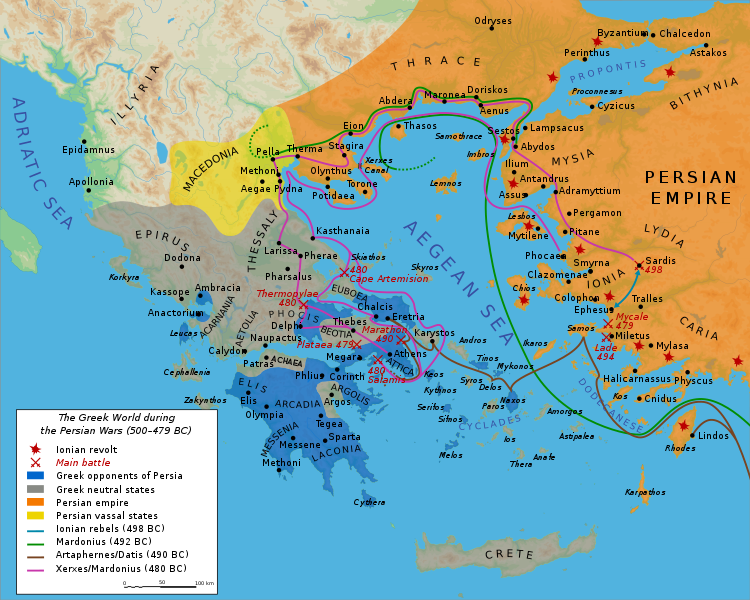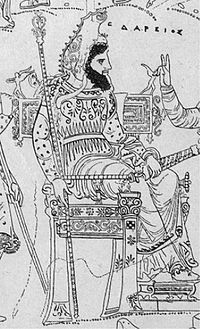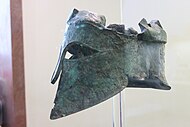
Hannibal was one of the sons of Hamilcar Barca, a grand Carthaginian leader. He had two brothers, Hasdrubal and Mago. His brothers-in-law were Hasdrubal the Fair and the Numidian king Naravas. After Carthage's defeat in the First Punic War, Hamilcar set out to improve his family's and Carthage's fortunes. With that in mind and supported by Gades, Hamilcar began the subjugation of the tribes of the Iberian Peninsula. Carthage at the time was in such a poor state that its navy was unable to transport his army to Iberia; instead, Hamilcar had to march it towards the Pillars of Hercules and transport it across the Strait of Gibraltar.

Hannibal much later said that when he came upon his father and begged to go with him, Hamilcar agreed and demanded that he swear that as long as he lived he would never be a friend of Rome. There is even an account of him at a very young age begging his father to take him to an overseas war. In the story, Hannibal's father took him up and brought him to a sacrificial chamber. Hamilcar held Hannibal over the fire roaring in the chamber and made him swear that he would never be a friend of Rome. Hannibal's father went about the conquest of Hispania. When his father drowned in battle, Hannibal's brother-in-law Hasdrubal succeeded to his command of the army with Hannibal serving as an officer under him. Hasdrubal pursued a policy of consolidation of Carthage's Iberian interests, even signing a treaty with Rome whereby Carthage would not expand north of the Ebro River, so long as Rome did not expand south of it. Hasdrubal also endeavoured to consolidate Carthaginian power through diplomatic relationships with native tribes.
After he assumed command, Hannibal spent two years consolidating his holdings and completing the conquest of Hispania south of the Ebro. However, Rome, fearing the growing strength of Hannibal in Iberia, made an alliance with the city of Saguntum, which lay a considerable distance south of the River Ebro and claimed the city as its protectorate. Hannibal perceived this as a breach of the treaty signed with Hasdrubal and so he laid siege to the city, which fell after eight months. Rome reacted to this apparent violation of the treaty and demanded justice from Carthage. In view of Hannibal's great popularity, the Carthaginian government did not repudiate Hannibal's actions, and the war he sought was declared at the end of the year. Hannibal was now determined to carry the war into the heart of Italy by a rapid march through Hispania and southern Gaul.
Hannibal departed New Carthage in late spring of 218 BC. He fought his way through the northern tribes to the Pyrenees, subduing the tribes through clever mountain tactics and stubborn fighting. He left a detachment of 11,000 troops to garrison the newly conquered region. At the Pyrenees, he released another 11,000 Iberian troops who showed reluctance to leave their homeland. Hannibal reportedly entered Gaul with 50,000 foot soldiers and 9,000 horsemen.
Hannibal recognized that he still needed to cross the Pyrenees, the Alps, and many significant rivers. Additionally, he would have to contend with opposition from the Gauls, whose territory he passed through. Starting in the spring of 218 BC, he easily fought his way through the northern tribes to the Pyrenees and, by conciliating the Gaulish chiefs along his passage, reached the Rhône River before the Romans could take any measures to bar his advance. Arriving at the Rhône in September, Hannibal's army numbered 38,000 infantry, 8,000 cavalry, and 37 war elephants.

In December of 218 BC, Hannibal's perilous march brought him into the Roman territory and frustrated the attempts of the enemy to fight out the main issue on foreign ground. His sudden appearance among the Gauls of the Po Valley, moreover, enabled him to detach those tribes from their new allegiance to the Romans before the latter could take steps to check the rebellion.
Publius Cornelius Scipio, the consul who commanded the Roman force sent to intercept Hannibal, had not expected Hannibal to make an attempt to cross the Alps, since the Romans were prepared to fight the war in Iberia. With a small detachment still positioned in Gaul, Scipio made an attempt to intercept Hannibal. Through prompt decision and speedy movement, he succeeded in transporting his army to Italy by sea, in time to meet Hannibal. Hannibal's forces moved through the Po Valley and were engaged in a small confrontation at Ticinus. Here, Hannibal forced the Romans, by virtue of his superior cavalry, to evacuate the plain of Lombardy. While the victory was minor, it encouraged the Gauls and Ligurians to join the Carthaginian cause, whose troops bolstered his army back to 40,000 men. Scipio was severely injured and retreated across the river Trebia to camp at Placentia with his army intact. But this gain was not without its loss, as Sempronius avoided Hannibal's watchfulness, slipped around his flank, and joined his colleague in his camp near the Trebbia River near Placentia. There, in December of the same year, Hannibal had an opportunity to show his superior military skill at Trebia; after wearing down the excellent Roman infantry he cut it to pieces by a surprise attack from an ambush in the flank.

Having secured his position in northern Italy by this victory, Hannibal quartered his troops for the winter with the Gauls, whose support for him abated. In the Spring of 217 BC, Hannibal decided to find a more reliable base of operations farther south. Expecting Hannibal to carry on advancing to Rome, Cnaeus Servilius and Gaius Flaminius (the new Consuls of Rome) took their armies to block the Eastern and Western routes Hannibal could use to get to Rome.
| Strength | |
|---|---|
| 30,000 men: (20,000 heavy infantry 10,000 cavalry, 37 war elephants) | 42,000 men: (18,000 legionaries, 20,000 Italian allies, 4,000 cavalry, |
| Casualties and losses | |
| 4-5,000 Infantry, Some Elephants | Approximately 26,000-28,000, up to 32,000 total casualties |
Arriving in Etruria in the spring of 217 BC, Hannibal decided to lure the main Roman army, under Flaminius, into a pitched battle, by devastating under his very own eye the area he had been sent to protect. At the same time, Hannibal tried to break the allegiance of Rome’s allies, by proving that Flaminius was powerless to protect them. Despite this, Hannibal found Flaminius still passively encamped at Arretium. Unable to draw Flaminius into battle by mere devastation, Hannibal marched boldly around his opponent’s left flank and effectively cut Flaminius off from Rome. Advancing through the uplands of Etruria, Hannibal provoked Flaminius to a hasty pursuit and, catching him in a defile on the shore of Lake Trasimenus, destroyed his army in the waters or on the adjoining slopes while killing Flaminius as well. He had now disposed of the only field force which could check his advance upon Rome, but, realizing that without siege engines he could not hope to take the capital, he preferred to exploit his victory by passing into central and southern Italy and encouraging a general revolt against the sovereign power. After Lake Trasimeno, Hannibal stated, "I have not come to fight Italians, but on behalf of the Italians against Rome".

| Commanders and leaders | |
|---|---|
| Hannibal | Gaius Flaminius † |
| Strength | |
| 30,000+ soldiers | 40,000 soldiers |
| Casualties and losses | |
| 2,500 killed and "many" dead from wounds | 15,000 killed |
Consul Varro, who was in command on the first day, is presented by ancient sources as a man of reckless nature and hubris, and was determined to defeat Hannibal. While the Romans were approaching Cannae, a small portion of Hannibal's forces ambushed the Roman army. Varro successfully repelled the Carthaginian attack and continued on his way to Cannae. This victory, though essentially a mere skirmish with no lasting strategic value, greatly bolstered the confidence of the Roman army, perhaps to overconfidence on Varro's part. Paullus, however, was opposed to the engagement as it was taking shape. Unlike Varro, he was prudent and cautious, and he believed it was foolish to fight on open ground, despite the Romans' numerical strength. This was especially true since Hannibal held the advantage in cavalry (both in quality and numerical terms). Despite these misgivings, Paullus thought it unwise to withdraw the army after the initial success, and camped two-thirds of the army east of the Aufidus River, sending the remainder of his men to fortify a position on the opposite side. The purpose of this second camp was to cover the foraging parties from the main camp and harass those of the enemy.

The two armies stayed in their respective locations for two days. During the second of these two days (August 1), Hannibal, aware that Varro would be in command the following day, left his camp and offered battle. Paullus, however, refused. When his request was rejected, Hannibal, recognizing the importance of the Aufidus' water to the Roman troops, sent his cavalry to the smaller Roman camp to harass water-bearing soldiers that were found outside the camp fortifications. According to Polybius, Hannibal's cavalry boldly rode up to the edge of the Roman encampment, causing havoc and thoroughly disrupting the supply of water to the Roman camp.
| Belligerents | |
|---|---|
| Carthaginian Republic Allied African, Spanish, and Gallic tribes | Roman Republic Allied Italian states |
| Commanders and leaders | |
| Hannibal, Maharbal, Mago | Gaius Terentius Varro, Lucius Aemilius Paullus † |
| Strength | |
| 50,000: 32,000 heavy infantry, 8,000 light infantry, 10,000 cavalry | 86,400: 40,000 Roman infantry, 40,000 Allied infantry, 2,400 Roman cavalry, 4,000 Allied cavalry |
| Casualties and losses | |
| Killed: 8,000 (Livy) 5,700 (Polybius) * 4,000 Gallic * 1,500 Spanish and African * 200 cavalry | Killed: 53,500-75,000 Romans and allied infantry 2,700 Roman and allied cavalry Captured: 3,000 Roman and allied infantry 1,500 Roman and allied cavalry |
Now you are about to see the view that the generals wish to have, and see the Gaul, Iberian and Carthaginian infantry with supported of Numidian and Iberian cavalry against the flexible and armed roman legions on open field, the fight will decide the future of West Mediterranean, and the world will not be the same before!










